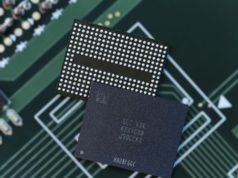
- Register
- Login
28°C
- Article
- . (0)
- Related content
Based on existing development and established supply chain of Micro LED, the possibility of successful development in terms of commercial applicability is about 50%, according to general director Wu Chih-I for Electronic and Optoelectronic System Research Laboratories (EOSRL) under the government-sponsored Industrial Technology Research Institute (ITRI).
Micro LED will be technologically successful, but commercial application hinges on cost-performance competitiveness with TFT-LCD and OLED. Makers are expected to make efforts to keep improving performance and decreasing production costs which will pose challenges for Micro LED, Wu said.
In comparison, brightness of Micro LED is 2-3 times that of OLED under the same power consumption, Wu noted. Micro LED entails much less investment than TFT-LCD to reach economies of scale, Wu said.
Micro LED is characterized by small size LED chips, Wu noted. Micro LED chips are so small that a 5-inch 400 by 600 smartphone-use panel needs to use nearly one million chips and an Ultra HD TV panel about 50 million chips, Wu indicated.
The core of Micro LED technology is mass transfer of small chips, Wu said. LuxVue Technology, a Micro LED developer acquired by Apple in May 2014, uses unique electrostatic adhesion for mass transfer, while others use vacuum pressure which is the simplest method but has low yield rates, Wu indicated. Currently, mass transfer of Micro LED chips is challenged by balancing cost and yield rate, Wu explained.
Viewing that Taiwan-based makers are unable to compete with large international enterprises such as Apple and Samsung Electronics in developing Micro LED technology, ITRI is organizing a consortium consisting of more than 20 Taiwan-based LED makers, LED material makers, IC design houses, IC packaging & testing service providers, TFT-LCD panel makers and system product makers, which will be established in November 2016, Wu noted. ITRI has been developing Micro LED for a while and is progressing toward small-volume trial production in early 2017, Wu noted.
Due to cost-performance competition, Micro LED is likely to be initially applied to small-size displays such as smartwatches, heads-up displays, VR or AR (augmented reality) devices as well as large-size display panels, and then, when production cost decreases significantly, to smartphones, TVs and PCs, Wu indicated.
-
UMC 14nm FinFET ready for production in 2Q17
Bits + chips | 22min ago
-
Component shortages putting pressure on smartphone players
IT + CE | 12h 22min ago
-
Microsoft to partner with Changhua government to push cloud for education
IT + CE | 12h 24min ago
-
KYEC posts another quarter of record profits
Bits + chips | 12h 27min ago
-
Nanya 3Q16 profits jump; Inotera turns profitable
Bits + chips | 12h 29min ago
-
PC demand to enjoy growth thanks to new processors from AMD and Intel
IT + CE | Oct 26, 21:58
-
Phison reports strong pre-tax earnings for 3Q16
Bits + chips – Newswatch | Oct 26, 21:52
-
Alchip to set up subsidiary in Hefei
Bits + chips | Oct 26, 21:51
-
Digitimes Research: Global ADAS production value to reach US$35 billion in 2018
Before Going to Press | Oct 26, 21:28
-
China market: Xiaomi Technology to launch 2 smartphones
Before Going to Press | Oct 26, 21:26
-
CyberLink nets NT$1.91 per share for January-September
Before Going to Press | Oct 26, 21:24
-
Panasonic, Fujitsu to develop energy-saving semiconductors
Before Going to Press | Oct 26, 21:22
-
Apple ships 45.5 million iPhone devices in fiscal 4Q16
Before Going to Press | Oct 26, 21:20
-
Chunghwa Picture Tubes China subsidiary procures equipment from Dafuku
Before Going to Press | Oct 26, 21:18
-
Oppo, Vivo to set up smartphone production lines in India
Before Going to Press | Oct 26, 21:17
-
Acer pushing new projects
Before Going to Press | Oct 26, 21:15
-
UMC 28nm technology accounts for 21% of 3Q16 revenues
Before Going to Press | Oct 26, 21:15
-
Taiwan-based startup Trans-IoT eyes air cleaner market
Before Going to Press | Oct 26, 20:51



- Wireless broadband developments in Southeast Asia markets
As of 2013, the 10 ASEAN nations had a total of over 700 million mobile subscriptions, with the CAGR from 2003-2013 reaching 24%. This Digitimes Research Special Report analyzes the various mobile broadband markets in ASEAN and looks at the respective trends in 4G LTE development for those markets.
- 2015 global tablet demand forecast
This Digitimes Research Special Report provides a 2015 forecast for the global tablet market and analyzes the strategies of key market players such as Google, Apple, Intel, and Microsoft.
- 2015 China smartphone panel trend forecast
This Digitimes Research Special Report analyzes the strategies of key China-based major panel makers BOE, Tianma and IVO for attacking the different market segments through technology and pricing, and their relationship to local vendors Huawei, Lenovo, ZTE, Xiaomi and Coolpad.







![[CES 2026] Quest For Perfect Color…Samsung To Push](https://loginby.com/itnews/wp-content/uploads/2025/12/CES-2026-Quest-For-Perfect-Color…Samsung-To-Push-100x75.jpg)
